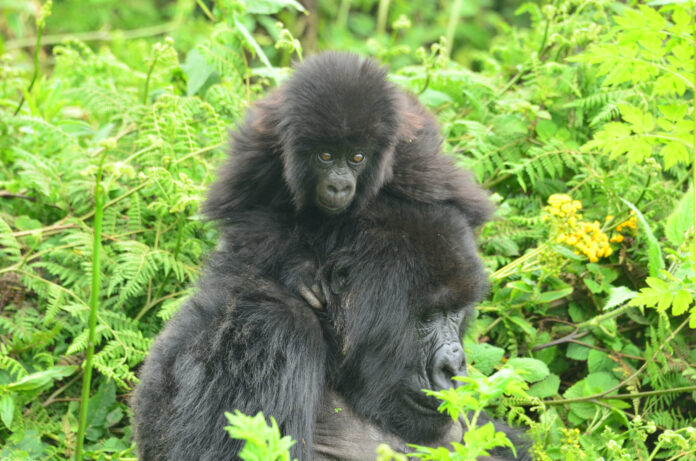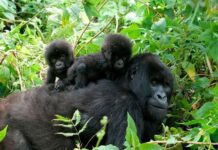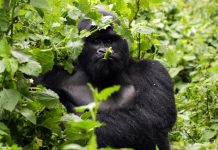Uganda is one of the three countries in the world where there are mountain gorillas and the rest living in the neighbouring Rwanda and Democratic of Congo. Mountain gorillas are Uganda’s prime tourist attraction and majority of these are in Bwindi Impenetrable National Park, with a few others in Mgahinga National Park, both in south-western Uganda.
Mgahinga Gorilla National Park is situated on the extreme south-west corner of Uganda on the slopes of the Virunga Terraces. It takes its name from Gahinga, the local word for the piles of volcanic stones cleared from farmland at the foot of the volcanoes. It borders Rwanda and the Democratic Republic of Congo.
Besides trekking gorillas in this park, you are able to track the golden monkeys, hike Mount Mgahinga, Sabyinyo, and Muhavura Mountains, and go for the Batwa cultural trail experience.
Bwindi Impenetrable National Park is located south-west of Uganda and is home to about half of all mountain gorillas. Bwindi was gazetted as a national park in 1991 and declared a UNESCO World Heritage Site in 1994.
The Impenetrable Forest protects an estimated 480 mountain gorillas roughly half of the world’s population, including several habituated groups, which can be tracked. In Bwindi, visitors have been allowed to view the mountain gorillas since April 1993.
The development of gorilla tourism and the habituation of gorillas to humans are proceeding very carefully because of the dangers to gorillas, such as contracting human diseases.
The biological diverse region also provides shelter to a further 120 mammals, including several primate species such as baboons and chimpanzee, as well as elephants and antelopes.
There are around 350 species of birds hosted in this forest including 23 Albertine Rift endemics. The varied habitats of Uganda’s oldest forest mean it is the ideal habitat for a variety of birds including the short-tailed Warbler and Blue –headed Sunbird as well as IUCN red data listed species.
Birding takes place along the main trail, the Buhoma Waterfall Trail and along the bamboo zone and Mubwindi Swamp trail in Ruhija.
The major activity in Bwindi Impenetrable Forest National Park is Gorilla trekking. The activity is limited only to a maximum of 8 people per day per a particular gorilla family. Gorilla permits are available at $700 USD per person and for Gorilla Habituation Experience costs $1500 per person.
Permits must be booked before since they are on a very high demand all year round. You can book yourself one by getting in touch with Uganda Wildlife Authority or contacting Gorilla Safari Tours for advice.
Bwindi is aptly named the Impenetrable Forest; paths pass through dense vegetation and can be steep, so take advantage of walking sticks offered at the start of a walk. A day trek through the dense forests of Bwindi Impenetrable Forest with a well-trained guide who explains the gorillas’ behaviours along the way is a lifetime experience.
The gorilla families are headed by a silver-back, a mature male- who selects places for the group to eat and sleep, and has many privileges including the right to feed first. The dominant silver-back generally determines the movements of the group, leading it to appropriate feeding sites throughout the year.
He mediates conflicts within the group and protects it from external threats. This privilege pays off for the rest of the family as if the group is threatened; the silver-back weighing up to 120kg will defend them to death.
Generally though, the gorilla is a gentle species, they are considered to be highly intelligent, have been observed using tools like other great apes, and communicate using a variety of vocal sounds. The mountain gorillas are generally gentle and very shy.
Severe aggression is rare in stable groups, but when two mountain gorilla groups meet, the two silverbacks can sometimes engage in a fight to the death, using their canines to cause deep, gaping injuries. For this reason, conflicts are most often resolved by displays and other threat behaviours that are intended to intimidate without becoming physical.
Mountain gorillas in Uganda can also be trekked in Mgahinga Gorilla National Park. Mgahinga has one habituated trans-boundary Nyakagezi gorilla group, a fairly nomadic bunch that have been known to cross the border into Rwanda and the Congo.
As its name suggests, it was created protect the rare mountain gorillas that inhabit its dense forests and it is also an important habitat for the endangered golden monkeys, as well as being important for wildlife.
The gorilla family includes the leader silverback Bugingo who is around 50 years old and father to most of the group, his silverback sons, Mark and Marfia and two black backs, Rukundo and Ndungutse who love to pose and play in the trees. The two females Nshuti and Nyiramwiza both have babies Furraha and Nkanda respectively.
Mgahinga Gorilla Park offers a rare chance in Uganda to track these striking creatures high in the dense bamboo forest on the Gahinga trail. The park also has a huge cultural significance, in particular for the indigenous Batwa pygmies.
For generations, Mgahingas’ dense forests were home to the indigenous Batwa-hunter gatherers and fierce warriors who depend on the forest for shelter, food and medicine. When the national park was established, the Batwa were chased from the forest and abandoned their low- impact, nomadic lifestyle.
The only time they were permitted to re-enter, the forest is as tour guides on the Batwa Trail, on which visitors will discover the magic of the Batwa’s ancient home while enjoying nature walks and learning about the cultural heritage.
The Batwa demonstrate hunting skills, gather honey, point out medicine plants and demonstrate how to make bamboo cups.
Visitors are invited to the Garama Cave, once a refuge for the Batwa where women of the community perform a sorrowful song which echoes eerily around the depths of the dark cave and leaves guests with a moving sense of the richness of this fading culture. The Batwa Cultural Trail costs $80 USD per person and it takes a full day.
What to bring on a gorilla safari in Uganda include: Good hiking boots, wet weather clothing and warm layers for the evenings since it gets cold and damp in Bwindi forest, insect repellent, sun glasses, rain gears, long sleeved shirt and trouser, a camera and extra batteries plus water proof bags to protect the cameras and phones, a hat, mineral water and snacks are also recommended as well as packed lunch for full day safaris.






